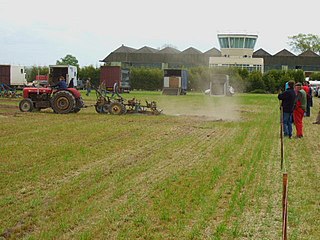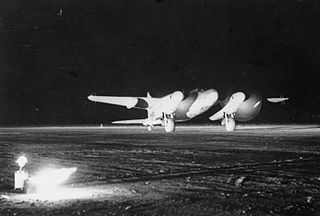
Newcastle International Airport is an international airport in Newcastle upon Tyne, England. Located approximately 7.7 mi (12.4 km) from Newcastle City Centre, it is the primary and busiest airport in North East England, and the second busiest in Northern England. In 2019, prior to the COVID-19 pandemic, Newcastle International handled 5.2 million passengers annually.

Royal Air Force Dishforth or more simply RAF Dishforth is a former Royal Air Force station near Thirsk in North Yorkshire, England. Opened in 1936, the base was used as a bomber airfield during the Second World War with both British and Canadian squadrons flying missions from the airfield. After the war, the base was used by various squadrons and training units before being disposed of in 1992 and handed over to the Army Air Corps.

Royal Air Force Leconfield or more simply RAF Leconfield is a former Royal Air Force station located in Leconfield, East Riding of Yorkshire, England.

Pembrey Sands Air Weapons Range is a Ministry of Defence air weapons range located near the village of Pembrey, Carmarthenshire, 3 miles (4.8 km) northwest of Burry Port and 10.3 miles (16.6 km) south of Carmarthen, Wales. Adjacent to the weapons range site is a former Royal Air Force station known as Royal Air Force Pembrey, or more simply RAF Pembrey, which closed in 1957 and of which part is now in civilian use as Pembrey Airport.

Royal Air Force Finningley or RAF Finningley was a Royal Flying Corps and Royal Air Force station at Finningley, in the Metropolitan Borough of Doncaster, South Yorkshire, England. The station straddled the historic county boundaries of both Nottinghamshire and the West Riding of Yorkshire.

Royal Air Force Scorton or more simply RAF Scorton is a former Royal Air Force satellite station located next to the village of Scorton in North Yorkshire, England. The base was opened in October 1939 as part of 13 Group RAF Fighter Command and a satellite station of RAF Catterick. It was used by the Royal Air Force, the Royal Canadian Air Force, and the United States Army Air Forces Ninth Air Force during the war.

Redhill Aerodrome is an operational general aviation aerodrome located 1.5 NM south-east of Redhill, Surrey, England, in green belt land.
Royal Air Force Sunderland or RAF Sunderland is a former Royal Air Force station in Sunderland. In 1958 the station was closed and the airfield became Sunderland Airport. Following the closure of the airport in 1984, the site has since been redeveloped as a manufacturing facility for Nissan cars – Nissan Motor Manufacturing UK, and as the location of an aviation museum, the North East Land, Sea and Air Museums (NELSAM).

Royal Air Force Ouston or more simply RAF Ouston is a former Royal Air Force station that was located near the village of Stamfordham and the village of Heddon-on-the-Wall on Hadrian's Wall near Newcastle upon Tyne. It was built as a Second World War aerodrome and is today used by the British Army. Just north of the airfield is Richmond Hill, Northumberland, in the parish of Stamfordham.

Royal Air Force Lindholme or more simply RAF Lindholme is a former Royal Air Force station in South Yorkshire, England. It was located 3.9 miles (6.3 km) south of Thorne and 6.9 miles (11.1 km) north east of Doncaster and was initially called RAF Hatfield Woodhouse.

Royal Air Force Detling or more simply RAF Detling is a former Royal Air Force station situated 600 feet (180 m) above sea level, located near Detling, a village about 4 miles (6.4 km) miles north-east of Maidstone, Kent.

Royal Air Force Acklington, simply known as RAF Acklington, is a former Royal Flying Corps and Royal Air Force station located 3.2 miles (5.1 km) south west of Amble, Northumberland and 8.8 miles (14.2 km) north east of Morpeth, Northumberland.
Royal Air Force Grangemouth or more simply RAF Grangemouth is a former Royal Air Force station located 3 mi (4.8 km) north east of Falkirk, Stirlingshire, Scotland.
Royal Air Force Thornaby or more simply RAF Thornaby was a former Royal Air Force Station located in the town of Thornaby-on-Tees, in the North Riding of Yorkshire, England. Fighter Command, Bomber Command and Coastal Command all operated from the base over its history, but its stint under Coastal Command is what the base was notable for, particularly in the air-sea rescue environment and the development of the Thornaby Bag. This was an emergency bag dropped to downed aircrew at sea and contained food, cigarettes and drink.

Royal Air Force Matlaske or more simply RAF Matlaske is a former Royal Air Force satellite station to RAF Coltishall, situated near Matlaske in Norfolk, England.

Royal Air Force Haverfordwest or more simply RAF Haverfordwest is a former Royal Air Force station located 2.1 miles (3.4 km) north of Haverfordwest, Pembrokeshire and 11 miles (18 km) south of Fishguard, Pembrokeshire, Wales.
Royal Air Force Rhoose, or more simply RAF Rhoose, is a former Royal Air Force satellite station located near Rhoose, 10 miles (16 km) south west of Cardiff and 2 miles (3 km) east of RAF St Athan, Vale of Glamorgan, Wales. It was first used by an Operational Training Unit in April 1942, as additional space, until May 1943. The airfield then remained unused until February 1944, when an Air Gunnery School operated out of RAF Rhoose until August 1944. It was then placed into care and maintenance until transferred to RAF Maintenance Command in November 1944. After the Second World War, the airfield became a sub-site of a Maintenance Unit. The MU and airfield closed in 1948.
Royal Air Force Catfoss, or more simply RAF Catfoss, is a former Royal Air Force station during the Second World War. It was located 4 miles (6.4 km) west of Hornsea, Yorkshire, England and 8 miles (13 km) north-east of Leconfield, Yorkshire, with the nearest village being Brandesburton.

No. 256 Squadron RAF was a flying squadron of the Royal Air Force which operated during the First and Second World Wars. Initially equipped with Dh6 and Kangaroo aircraft, it operated Defiant Mk IIs, Beaufighters, and Mosquitoes in the Second World War.

Royal Air Force Hutton Cranswick or more simply RAF Hutton Cranswick is a former Royal Air Force station located to the south of Driffield and immediately south west of the village of Hutton Cranswick in the East Riding of Yorkshire, England. The station was developed as a fighter base with many Spitfire fighter squadrons passing through. It was used by the Royal Air Force, the Royal Canadian Air Force (RCAF), and several Polish Fighter Squadrons of the RAF. It was opened in 1942, and disposed of in 1946.
















